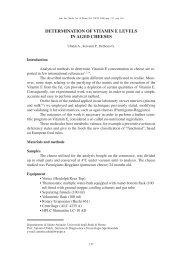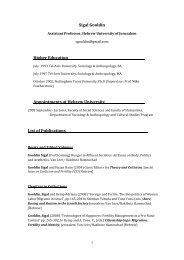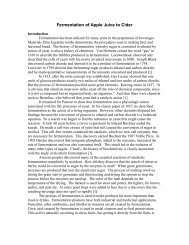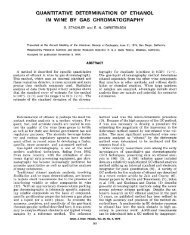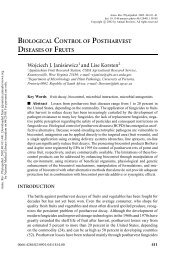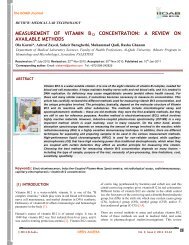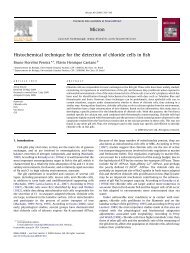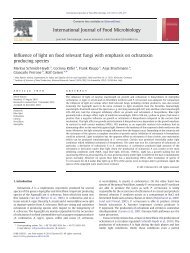On the gelling behaviour of 'nopal' (Opuntia ficus indica) low ...
On the gelling behaviour of 'nopal' (Opuntia ficus indica) low ...
On the gelling behaviour of 'nopal' (Opuntia ficus indica) low ...
You also want an ePaper? Increase the reach of your titles
YUMPU automatically turns print PDFs into web optimized ePapers that Google loves.
The evolution <strong>of</strong> <strong>the</strong> mechanical moduli with temperature<br />
was recorded at varying frequencies in order to glean<br />
fur<strong>the</strong>r understanding <strong>of</strong> <strong>the</strong> molecular mechanisms and<br />
processes underlying CPAE gel formation in <strong>the</strong> presence<br />
<strong>of</strong> Ca 2+ . Fig. 5 illustrates <strong>the</strong> formation and melting <strong>of</strong> a<br />
representative gel <strong>of</strong> R 0.35 on cooling and heating, respectively.<br />
The evolution <strong>of</strong> G 0 and G 00 during cooling program<br />
shows a monotonic sigmoidal curve for <strong>the</strong> increase <strong>of</strong> both<br />
moduli in <strong>the</strong> range <strong>of</strong> 10–40 °C. Indeed <strong>the</strong> shape <strong>of</strong> <strong>the</strong> G 0<br />
and G 00 temperature traces resembles that <strong>of</strong> a sol-gel transition,<br />
similar in kind to that which determines <strong>the</strong> <strong>gelling</strong><br />
behavior <strong>of</strong> o<strong>the</strong>r polysaccharides, notably agarose<br />
10000<br />
1000<br />
100<br />
10<br />
1<br />
0.1<br />
100000<br />
10000<br />
1000<br />
100<br />
10<br />
G' (Pa)<br />
G' (Pa)<br />
ω = 1.0 rad/s<br />
ω = 2.1 rad/s<br />
ω = 4.6 rad/s<br />
ω = 10.0 rad/s<br />
ω = 21.5 rad/s<br />
1<br />
0 20 40 60 80 100<br />
A. Cárdenas et al. / Carbohydrate Polymers 73 (2008) 212–222 219<br />
(Mohammed, Hember, Richardson, & Morrris, 1998), jcarrageenan<br />
(Piculell, Borgström, Chronakis, Quist, & Viebke,<br />
1997), and gellan (Nishinari, 1996). However, this<br />
process cannot be regarded strictly as a sol-gel transition,<br />
as a pre-existing weak-gel structure is already formed at<br />
<strong>the</strong> onset <strong>of</strong> <strong>the</strong> steep increase <strong>of</strong> <strong>the</strong> storage and loss moduli.<br />
Heating traces <strong>of</strong> both G 0 and G 00 recorded in <strong>the</strong> range<br />
10 to 60 °C are shown in <strong>the</strong> same plots. Clearly, a large<br />
hysteresis is observed between cooling and melting processes<br />
and <strong>the</strong> gel structure was found to persist even at<br />
60 °C, <strong>the</strong> highest temperature <strong>the</strong> system was taken up<br />
to. This behavior was found in contrast with previous stud-<br />
a b c<br />
G" (Pa)<br />
0.01<br />
d e f<br />
G" (Pa)<br />
0 20 40 60 80 100<br />
Temperature (ºC) Temperature (ºC) Temperature (ºC)<br />
1<br />
0.1<br />
1<br />
0.1<br />
tan δ<br />
Tgel=62.5ºC<br />
Tgel=26.1ºC<br />
0 20 40 60 80 100<br />
Fig. 6. Variation <strong>of</strong> <strong>the</strong> elasticity modulus G 0 (a and d), <strong>the</strong> loss modulus (b and e) and <strong>the</strong> liquid character index tand (c and f) during cooling (at 1 °C/<br />
min strain, c = 0.05, at frequencies, x, <strong>indica</strong>ted in (a)) <strong>of</strong> pectin gels added with CaCl2 at stoichiometric levels R (=2[Ca 2+ ]/[COO ]), <strong>of</strong> 0.21 (a–c) and<br />
0.42 (d–f). (c and f) The critical rheological <strong>gelling</strong> temperature (T gel).<br />
tan δ<br />
0.3<br />
0.2<br />
0.1<br />
0.0<br />
-0.1<br />
-0.2<br />
dtan δ/dT




